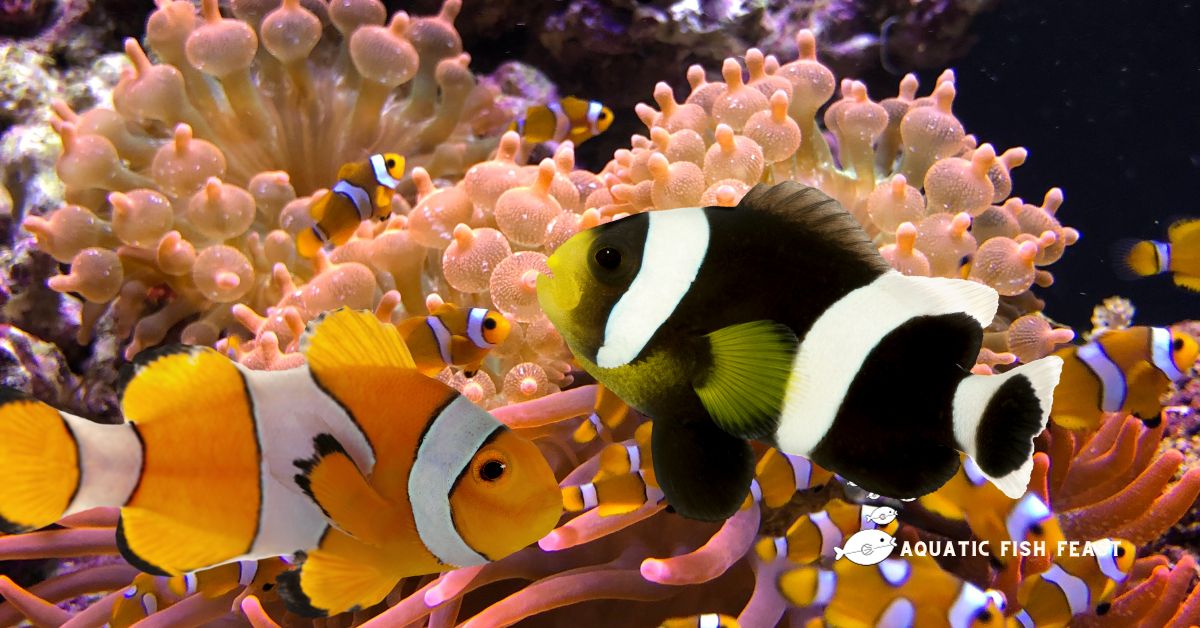Do you want to know if Clownfish can change from female to male? In this article, Let me explain all you need to know about clownfish metamorphosis.
Clownfish, also known as three-banded anemonefish, have a remarkable ability to undergo sex change throughout their life. Contrary to common belief, all clownfish begin their lives as males.
However, as they age and external variables impact their development, some of them go through a spectacular change, changing from male to female.
But how does this incredible transformation unfold? The solution is found in the complicated mechanics of their biology.
Clownfish adapt to their surroundings through hormonal oscillations, which cause dramatic alterations in their reproductive systems, culminating in a sex change.
This characteristic, known as protandry, is an important adaptation for assuring the survival of their species in dynamic reef habitats.
Now, let’s get started.
Read Also: What Do Clownfish Like To Eat?
Table of Contents
Can A Female Clownfish Reverse Back To Male
There is no way for females to transform into guys. Males, on the other hand, are capable of transitioning into females in certain circumstances.
If there are two female Clownfish, one will kill the other eventually (and by 2.5 inches, it should have already changed).
In the natural world, Clownfish adhere to a tight hierarchy.
Everyone begins life as a man, but only the strongest individual will eventually mature into a female. Should the female pass away, the dominant male would transform into a female.
There is no use in the female transforming into a guy when many more men are already waiting in the ranks to take over.
How do Clownfish change their sex?
It’s fascinating how Mother Nature has evolved many techniques for determining if an animal is male or female.
In humans, sex determination is frequently reduced to the existence of X and Y chromosomes.
Individuals with an XY combination usually grow as males, but those with two X chromosomes develop as females.
In most birds, the reverse is true.
The female possesses two copies of the sex-opposite chromosomes, W and Z, whereas the male has two copies of the same chromosome, Z. In birds, the mother chooses the sex of the young, but in humans, the father does.
Other animals lack sex chromosomes, and their gender is decided differently.
For instance, all turtles are males if their eggs are incubated below 86 degrees Fahrenheit, and all are females if they are beyond 86 degrees.
It’s especially difficult for Clownfish like Nemo. Male Clownfish are born at birth.
A clownfish group comprises a dominant male and female and 0-4 young males.
So, where did the female in the group come from? At the female’s death, the dominant male becomes the dominant female, and one of the juveniles assumes the role of the dominant male.
What Are The 2 Main Reasons Clownfish Change Gender
Clownfish shift gender mainly for the two reasons listed below.
1. duplication
One of the most important reasons for Clownfish to shift gender is reproduction.
Usually, only one female is in the group, and she is the most dominant and aggressive.
The female clownfish mates with the group’s most dominant male, generally the breeding male.
When a group’s female Clownfish dies, the breeding male changes into a female to ensure that the reproductive cycle is not broken.
The capacity of Clownfish to shift gender has maintained their survival and population growth.
2. No Need to Look for a Partner
In their native environment, Clownfish and sea anemones have a symbiotic connection.
For survival, many Clownfish establish a group and remain near the sea anemones.
Because Clownfish are so small, they are an easy meal for any large fish in the wild.
Staying near the sea anemones protects them since they defend themselves against predators using the poisonous tentacles of the sea anemones.
They seldom leave their host anemones to live on their own.
When the group’s female Clownfish dies, the males do not find a new female to replace her.
Instead, the dominant male in the group becomes a female, and the male next in line becomes the breeding male.
This permits the surviving Clownfish to continue breeding without leaving the group and venturing into dangerous waters where they may be predated.
When Do Clownfish Change Gender
When the dominant female of their group dies, Clownfish can switch genders and become males.
As a result of the fact that all Clownfish are born male, one of the dominant males must transition into a female so that they can reproduce.
There is just one other person who is a woman in this group.
The reproductive male is the group’s second-largest and most dominating male. He is also the most powerful.
When the dominant female Clownfish in a group dies, the fertile male Clownfish will undergo the metamorphosis into a female to take her place as the group leader.
After that, the reproductive male role is given to the subsequent dominant male in the group.
At this point, every male Clownfish in the group climbs higher in the food chain than previously.
The freshly created pair of Clownfish will continue to reproduce until one of them dies.
After that, the cycle of changing genders will continue until no more dominant females remain in the group.
Why Can Clownfish Change Their Gender
The transformation from childhood to adulthood is astonishing. However, this is not an extremely rare occurrence.
An estimated two percent of fish species can suffer from hermaphroditism in some form.
That’s around 500 different species over the entire planet.
To go back to the subject at hand, the social structure of Clownfish, as well as their capacity to change sex, may be traced back to the sea anemone, which is their preferred home.
The association between Clownfish and these immobile creatures is a remarkable and unique example of symbiosis.
The fish utilizes the anemone’s toxicity to ward off potential predators and locate food scraps, while the anemone relies on the fish’s waste for sustenance and to attract prey.
If it were not for the anemone’s protection, Clownfish would have been an easy meal for just about any fish that was bigger than them.
They are not very large fish, but they have brighter colors and also have an awkward swimming style that is not very effective.
Because of the abundance of barracudas and other massive fish in the environment, marlins and memos seldom swim away from their host.
When the current alpha matriarch passes away, it will be extremely difficult to integrate a new female into the group because of this situation.
Therefore, a clownfish’s unique ability to change sex eliminates the need for the fish to explore unexplored regions in search of a partner.
This saves the fish time and energy.
How Long Does It Take For A Clown Fish To Change Gender
The time it takes for a clownfish to change sex ranges between 30 and 50 days, according to the species.
This process occurs when the dominant female in a group either passes away or is removed from the group; at this point, one of the surviving males transitions into a female.
Differential expression in the gonads can still be observed up to 50 days after removing the original female.
Still, the primary transcriptional response driving this shift at the brain level is often finished within the first 30 days after the original female has been removed.
After the process, the males transform into young females and are prepared to assume a reproductive role.
Final Thought
Having established that a clownfish can change gender from female to male, I hope that this article will address your question related to whether a female clownfish can become a male.
You say that clownfish certainly are one of the most used and popular marine aquarium fish.
I have aroused your interest in the potential of keeping an intriguing designer species, Clownfish, inside the confines of your tank.
OTHER ARTICLES:
- Can Clownfish Live Alone
- Are Clownfish Aggressive: Discover Now!
- Can Clownfish And Goldfish Live Together
- Can Clownfish And Dory Live Together
- Can Clownfish Reproduce Asexually
- How Many Clownfish Should Be Kept Together
- How Many Clownfish Can Safely Coexist In A Tank
- When And How Clownfish Lay Their Eggs(Unlocking The Secrets)
- Want To Know Why Do Clownfish Turn Black, Now You Can




